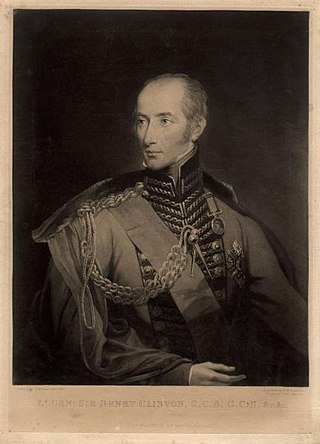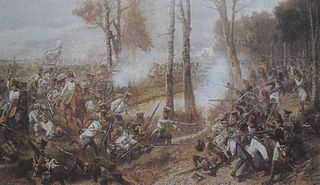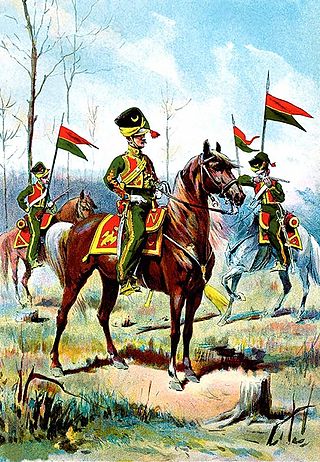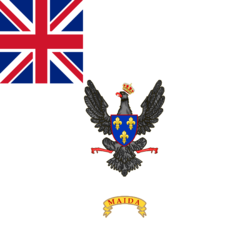
The Napoleonic Wars (1803–1815) were a series of conflicts fought between the First French Empire under Napoleon (1804–1815) and a fluctuating array of European coalitions. The wars originated in political forces arising from the French Revolution (1789–1799) and from the French Revolutionary Wars (1792–1802), and produced a period of French domination over Continental Europe. The wars are categorised as seven conflicts, five named after the coalitions that fought Napoleon, plus two named for their respective theatres; the War of the Third Coalition, War of the Fourth Coalition, War of the Fifth Coalition, War of the Sixth Coalition, War of the Seventh Coalition, the Peninsular War, and the French invasion of Russia.

The Napoleonic era is a period in the history of France and Europe. It is generally classified as including the fourth and final stage of the French Revolution, the first being the National Assembly, the second being the Legislative Assembly, and the third being the Directory. The Napoleonic era begins roughly with Napoleon Bonaparte's coup d'état, overthrowing the Directory, establishing the French Consulate, and ends during the Hundred Days and his defeat at the Battle of Waterloo. The Congress of Vienna soon set out to restore Europe to pre-French Revolution days. Napoleon brought political stability to a land torn by revolution and war. He made peace with the Roman Catholic Church and reversed the most radical religious policies of the Convention. In 1804 Napoleon promulgated the Civil Code, a revised body of civil law, which also helped stabilize French society. The Civil Code affirmed the political and legal equality of all adult men and established a merit-based society in which individuals advanced in education and employment because of talent rather than birth or social standing. The Civil Code confirmed many of the moderate revolutionary policies of the National Assembly but retracted measures passed by the more radical Convention. The code restored patriarchal authority in the family, for example, by making women and children subservient to male heads of households.

General Sir John Coape Sherbrooke, was a British soldier and colonial administrator. After serving in the British army in Nova Scotia, the Netherlands, India, the Mediterranean, and Spain, he was appointed Lieutenant-Governor of Nova Scotia in 1811. During the War of 1812, his policies and victory in the conquest of present-day Maine, renaming it the colony of New Ireland, led to significant prosperity in Nova Scotia.

The Battle of Maida, fought on 4 July 1806 was a battle between the British expeditionary force and a French force outside the town of Maida in Calabria, Italy during the Napoleonic Wars. John Stuart led 5,236 Anglo-Sicilian troops to victory over about 5,400 Franco-Italian-Polish troops under the command of French general Jean Reynier, inflicting significant losses while incurring relatively few casualties. Maida is located in the toe of Italy, about 30 kilometres (19 mi) west of Catanzaro.

Lieutenant-General Sir Henry Clinton was a British Army officer and a general officer during the Napoleonic Wars.

The Imperial-Royal or Imperial Austrian Army was the armed force of the Habsburg monarchy under its last monarch, the Habsburg Emperor Francis II, composed of the Emperor's army. When the Holy Roman Empire was dissolved in 1806, it assumed its title of the troops of the Austrian Empire under the same monarch, now known as Emperor Francis I of Austria.
The Prussian Regiment was a foreign regiment of the French Imperial Army formed in late 1806 and made up by Prussian prisoners of war. Though it only served for a short time, the regiment saw service in the Peninsular War, but was disbanded in 1813 following the 1813 reorganisation of the foreign regiments.

The Legion of the Vistula was a unit of Poles in the service of Napoleonic France, one of the larger Polish legions of the Napoleonic period.

The British Army during the Napoleonic Wars experienced a time of rapid change. At the beginning of the French Revolutionary Wars in 1793, the army was a small, awkwardly administered force of barely 40,000 men. By the end of the period, the numbers had vastly increased. At its peak, in 1813, the regular army contained over 250,000 men. The British infantry was "the only military force not to suffer a major reverse at the hands of Napoleonic France."

The military career of Napoleon Bonaparte spanned over 20 years. He led French armies in the French Revolutionary Wars and later, as emperor, in the Napoleonic Wars. Despite his rich war-winning record, Napoleon's military career ended in defeat. Napoleon has since been regarded as a military genius and one of the finest commanders in history. His wars and campaigns have been studied at military schools worldwide. He fought more than 80 battles, losing only ten, mostly towards the end when the French army was not as dominant. The French dominion collapsed rapidly after the disastrous invasion of Russia in 1812. Napoleon was defeated in 1814 and exiled to the island of Elba, before returning to France. He was finally defeated in 1815 at the Waterloo. He spent his remaining days in British custody on the remote volcanic tropical island of Saint Helena.

The Royal Corsican Rangers was a unit of the British Army, composed mainly of émigrés, which served during the later part of the French Revolutionary Wars and throughout the Napoleonic Wars.

Arthur Wellesley, 1st Duke of Wellington,, was one of the leading British military and political figures of the 19th century. Often referred to solely as "The Duke of Wellington", he led a successful military career in the Indian subcontinent during the Fourth Anglo-Mysore War (1798–99) and the Second Anglo-Maratha War (1803–1805), and in Europe during the Napoleonic Wars (1803–1815).

The Lithuanian Tatars of the Imperial Guard were a light cavalry squadron of Napoleon's Imperial Guard, in the service of the French Army from 1812 to 1814. The Lithuanian Tatars, descendants of Crimean Tatars, were organized into a single squadron at the beginning of the Russian Campaign. Their first commander was Squadron Leader Achmatowicz, who was killed at Vilnius and succeeded by Captain Ulan, who led the unit through the remainder of the war. Following the First Abdication of Napoleon, all foreign units were disbanded, and the regiment followed.
The Royal Regiment of Malta was an infantry regiment in the British Army which existed from 1804 to 1811. It was raised in Malta, then a British protectorate, with the intention of being sent in overseas expeditions. The unit was raised following the success of the Maltese Light Infantry at the Siege of Porto Ferrajo in 1801.
The Capture of Capri, also known as the Battle of Capri or Capri Campaign was an attempted invasion by émigré and foreign units of the British Army to establish a foothold in the area of Capri in the Bay of Naples.

The FrenchImperial Naval Corps was the branch of the French Imperial Navy responsible for administering the infantry and artillery which was tasked with manning and utilising the weapons on the Navy's ships. The corps comprised two 'official' branches and Naval Artillery and one 'unofficial branch'. The Naval Infantry and Naval Artillery formed the 'official' branches as they were under the direct control of the navy and Naval corps. However, the Coastal Artillery was de facto an 'unofficial' branch, as it remained under control of the army for operational duties, while administration and supply was given to the Navy.
The York Light Infantry Volunteers, also known as the Barbados Volunteer Emigrants, was a foreign light infantry regiment of the British Army during the Napoleonic Wars. It was formed in September 1803 from the Dutch garrisons of the captured Batavian colonies of Demerara, Essequibo, and Berbice. Additions to the regiment were recruited from the ranks of prisoners of war, and the regiment was also the recipient of the majority of deserters taken in the Peninsular Wars. The regiment served its whole existence in the West Indies, fighting in the British West Indies campaign. It was present at the Battle of Suriname in 1804 and at the invasions of Martinique and Guadeloupe in 1809 and 1810 respectively. It finished the Napoleonic Wars as garrison at Jamaica, before in early 1817 being sent to England, where it was disbanded on 19 March.













